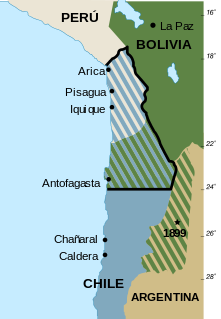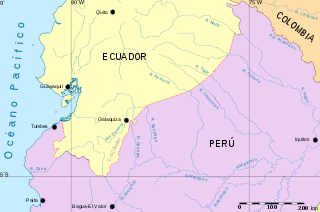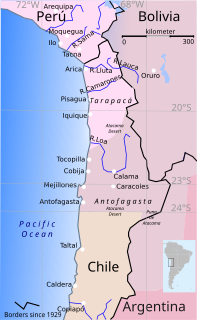 W
WThe Atacama border dispute is a dispute between Chile and Bolivia that stems from the transfer of the Bolivian Coast and the southern tip of Peru to Chile in the 19th century through the Treaty of Ancón with Peru and the Treaty of Peace and Friendship of 1904 between Chile and Bolivia after the War of the Pacific (1879–1883). The dispute is considered to be ongoing because Bolivia still claims a sovereign access to the Pacific Ocean. The conflict takes its name from the Atacama Desert on which lies the disputed territory. Due to a transfer of land to both Argentina and Chile during the Chilean annexation of the Bolivian coast in 1879, the Puna de Atacama dispute—this spin-off dispute was settled in 1899.
 W
WThe Cenepa War, also known as the Alto Cenepa War, was a brief and localized military conflict between Ecuador and Peru, fought over control of an area in Peruvian territory near the border between the two countries. The two nations had signed a border treaty following the Ecuadorian–Peruvian War of 1941, but Ecuador later disagreed with the treaty as it applied to the Cenepa and Paquisha areas, and in 1960 Ecuador declared the treaty null and void.
 W
WPeru v Chile is a public international law case concerning a territorial dispute between the South American republics of Peru and Chile over the sovereignty of an area at sea in the Pacific Ocean approximately 37,900 square kilometres (14,600 sq mi) in size. Peru contended that its maritime boundary delimitation with Chile was not fixed, but Chile claimed that it holds no outstanding border issues with Peru. On January 16, 2008, Peru brought forth the case to the International Court of Justice at The Hague, the Netherlands, which accepted the case and formally filed it as the Case concerning maritime delimitation between the Republic of Peru and the Republic of Chile - Perú v. Chile.
 W
WThe territorial dispute between Ecuador and Peru was the source of a long period of intermittent armed conflict between the two countries. This dispute was a consequence of each country's interpretation of what Real Cedulas Spain used to precisely define its colonial territories in the Americas. After independence, all of Spain's colonial territories signed and agreed to proclaim their limits in the basis of the principle uti possidetis juris which accepts the Spanish colonial borders of 1810 as the borders of the new republics. Thus the borders of Gran Colombia which included Ecuador, Colombia and Venezuela would follow the borders of the Viceroyalty of New Granada, and Peru the Viceroyalty of Peru in 1810. However, Peru was not satisfied with this and tried to set the date of her Uti Possitedis to 1824 – a time when Peru was officially independent with territories Peru militarily occupied since 1820.
 W
WThe Paquisha War or Fake Paquisha War was a military clash that took place between January and February 1981 between Ecuador and Peru over the control of three watchposts. While Peru felt that the matter was already decided in the Ecuadorian–Peruvian War of 1941, Ecuador did not agree with the Rio de Janeiro Protocol. Later in 1998 the Guarantors of the Rio Protocol ruled that the border of the undelimited zone was indeed the line of the Cordillera del Cóndor, as Peru had been claiming since the 1940s.
 W
WThe Tacna–Arica compromise or Treaty of Lima was a series of documents that settled the territorial dispute of both Tacna and Arica provinces of Peru and Chile respectively. According to the Treaty, the Tacna-Arica Territory was divided between both countries; Tacna being awarded to Peru and with Chile retaining sovereignty over Arica. Chile also agreed to pay up to 6 million dollars in compensation to Peru.
 W
WThe War of the Pacific, also known as the Saltpeter War and by multiple other names, was a war between Chile and a Bolivian–Peruvian alliance from 1879 to 1884. Fought over Chilean claims on coastal Bolivian territory in the Atacama Desert, the war ended with a Chilean victory, which gained for the country a significant amount of resource-rich territory from Peru and Bolivia. The Chilean Army took Bolivia's nitrate-rich coastal region, and Peru was defeated by the Chilean Navy.